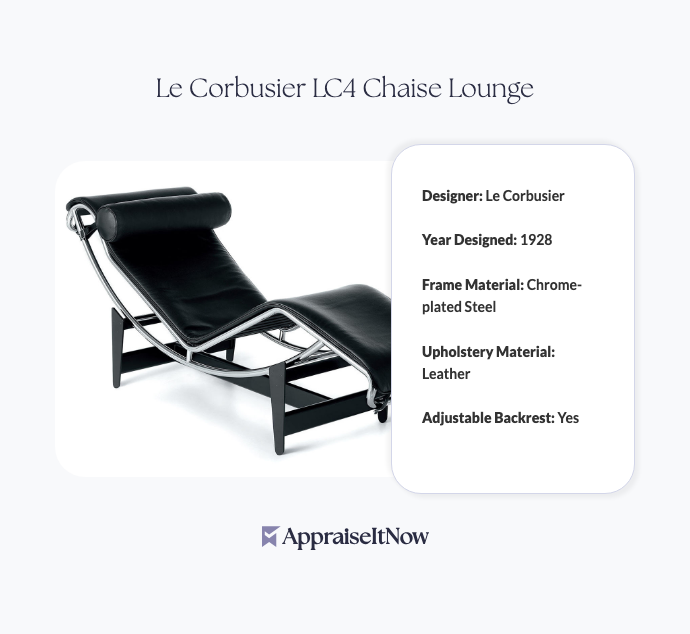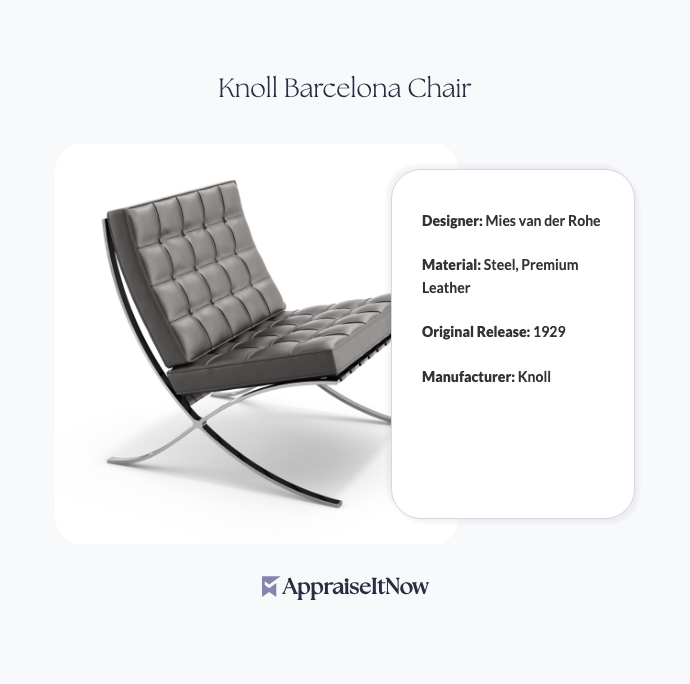<h1>How to Get Your Eames Lounge Chair 670 671 Appraised</h1>
<p>The Eames Lounge Chair 670 and 671 represent some of the most coveted mid-century modern furniture pieces ever created, commanding valuations between <strong>$3,500 and $12,000</strong> depending on age, condition, and authenticity. Whether you're inheriting a family heirloom, considering a sale, or need documentation for insurance purposes, understanding how to properly appraise your chair ensures you capture its true market value and protect your investment.</p>
<h2>Understanding Eames Lounge Chair Value and Market Demand</h2>
<p>Your Eames Lounge Chair 670 or 671 sits at the intersection of design history, craftsmanship, and investment potential. Designed by the legendary husband-and-wife team Charles and Ray Eames and first introduced in <strong>1956</strong>, these chairs epitomize mid-century modern excellence. The iconic silhouette, crafted from premium materials including molded plywood, genuine leather, and chrome, has made the 670/671 series continuously desirable among collectors, interior designers, and design enthusiasts worldwide.</p>
<p>The value difference between a heavily used example at the lower end and a pristine, rare variant at the premium tier reflects market realities: the Eames aesthetic has aged remarkably well, but condition and originality dramatically affect worth. Unlike mass-produced furniture that depreciates quickly, authentic Eames pieces often appreciate or hold value steadily over decades, making them a distinct category within the broader furniture market.</p>
<div class="callout tip"><p><strong>Market Insight</strong></p>
<p>Eames Lounge Chairs consistently rank among the most forged designer furniture pieces. Proper appraisal from a certified expert can authenticate your chair and dramatically increase its credibility and value.</p></div>
<h2>Key Factors That Determine Your Chair's Appraisal Value</h2>
<p>When evaluating your 670 or 671 model, professional appraisers assess multiple dimensions beyond the simple presence of the chair itself. Understanding these factors helps you recognize what drives your specific piece's market position.</p>
<p>The <strong>manufacturing year</strong> significantly influences value. Original 1956-1960s production runs command premium prices, particularly if your chair carries early Herman Miller manufacturing labels with matching serial numbers on the frame and plywood shell. The question of "how to tell the age of an Eames Chair" becomes central to valuation—original factory stamps, rivet patterns, and leather specifications all provide dating clues that experienced appraisers recognize immediately.</p>
<p><strong>Leather condition and color</strong> represents another major value driver. Your chair's leather—whether rosewood brown, black, or premium finishes—must be evaluated for cracks, fading, patina, and repairs. Interestingly, when did Eames stop using rosewood as a standard finish? The company phased out rosewood leather finishes in favor of other premium options during the 1970s and beyond, making rosewood examples from earlier decades particularly desirable. Original, well-maintained leather in rich colors typically adds 15-25% to valuation compared to heavily worn examples requiring restoration.</p>
<p>The <strong>plywood shell's integrity</strong> directly affects safety and value. Original molded plywood maintains structural soundness better than copies, which frequently suffer from delamination or warping. Professional appraisers examine the underside and edges where authentic Eames construction reveals proper lamination, proper veneering, and consistent color throughout—hallmarks that distinguish genuine Herman Miller production from reproductions or later variants.</p>
<div class="callout note"><p><strong>Authentication Focus</strong></p>
<p>Authentic 670/671 models feature specific hardware configurations, stitching patterns, and wood grain orientations that counterfeit producers frequently misrepresent. Professional appraisals document these authenticating details with photographic evidence.</p></div>
<h2>Identifying Authentic vs. Reproduction Eames Chairs</h2>
<p>The proliferation of Eames Lounge Chair replicas has created a market reality: how to identify an authentic Eames Lounge Chair becomes essential knowledge before seeking appraisal. Authentic pieces produced by Herman Miller command exponentially higher values than quality reproductions, sometimes fetching 5-10 times the price of modern copies.</p>
<p>Authentic Eames 670/671 chairs display consistent construction quality with hand-finished details. Look for <strong>matching serial numbers</strong> on both the leather shell tag and the aluminum frame, clear <strong>Herman Miller branding</strong> with production date stamps, and specific <strong>stitching patterns</strong> that replicas struggle to replicate exactly. The <strong>chrome base and legs</strong> on genuine pieces reflect a particular finish quality and weight that distinguishes them from lighter-gauge reproductions.</p>
<p>Are Eames lounge chairs still made? Yes—Herman Miller continues manufacturing Eames Lounge Chairs, but contemporary production carries different pricing structures and carries designer status rather than collectible value premiums. Vintage original models from the 1950s-1970s maintain distinct market positioning because they represent historical artifacts of design innovation, not simply comfortable furniture.</p>
<p>This distinction profoundly affects appraisal methodology. When you engage professional <a href="/types/antique-furniture">antique furniture appraisal</a> specialists, they're evaluating your chair as a design artifact with historical significance, not merely functional seating. This perspective directly translates to higher valuations for authenticated originals.</p>
<h2>Condition Assessment and Valuation Impact</h2>
<p>Professional appraisers grade Eames Lounge Chair condition on detailed scales that reflect market expectations. Your chair's valuation category depends on cumulative condition factors rather than a single flaw or strength.</p>
<p>An <strong>excellent condition</strong> chair (valued at $10,000-$12,000+) displays minimal wear, original hardware, supple leather with consistent patina rather than cracks, and a structurally sound plywood shell. These examples typically show light use and careful maintenance throughout their lifespan. <strong>Very good condition</strong> examples ($8,000-$10,000) exhibit normal wear patterns, possibly one minor repair, and leather that remains functional though showing age. <strong>Good condition</strong> pieces ($5,000-$8,000) display obvious wear, possible leather restoration, and may require minor adjustments to maintain comfort and safety.</p>
<p>The restoration history becomes critically important during appraisal. While professional leather restoration by qualified specialists can preserve value or even enhance it, amateur repairs, non-original replacement components, or structural modifications substantially reduce worth. Professional appraisers evaluate whether past work was executed to conservation standards or compromised originality.</p>
<div class="callout tip"><p><strong>Preservation Value</strong></p>
<p>Maintaining original materials—even well-worn leather—often preserves more value than replacement with new materials. Appraisers typically recommend conservative restoration approaches rather than complete overhauls.</p></div>
<h2>Do Eames Lounge Chairs Hold Their Value?</h2>
<p>This question concerns collectors and potential buyers equally. The answer is nuanced: authentic Eames pieces demonstrate strong value retention compared to typical furniture, but they're not universally appreciating assets. Several factors influence whether your chair maintains, increases, or decreases in value over time.</p>
<p>Rarity and production year play outsized roles. Original early production models become increasingly scarce as years pass, naturally supporting value. Chairs used in documented interior design projects or owned by notable designers command premiums reflecting their provenance. Conversely, common later-production variants or pieces with significant damage histories may appreciate slowly or appreciate only with broader market improvements in mid-century modern collecting.</p>
<p>Market trends affecting <a href="/types/personal-property">personal property</a> valuations influence Eames chairs alongside broader design cycles. Mid-century modern experiences periodic resurgence in design popularity, which typically elevates comparable furniture values during those periods. However, appraisers note that authentic Eames pieces show more stable value curves than trend-dependent furniture, suggesting their appeal transcends cyclical fashion preferences.</p>
<h2>How to Prepare Your Chair for Professional Appraisal</h2>
<p>Maximizing your appraisal outcome begins with thoughtful preparation. Gather any documentation you possess: original purchase receipts, Herman Miller certificates of authenticity, photographs from earlier ownership, repair records, and provenance details. These materials significantly strengthen your appraisal report's credibility and may add measurable value to your piece.</p>
<p>Photograph your chair comprehensively from multiple angles, capturing the underside where manufacturing stamps and construction details appear, close-ups of the plywood shell grain and any visible labels, leather detail shots showing wear patterns and color consistency, and full-room context photos showing how the piece integrates into contemporary interiors. These visual records help appraisers conduct research before physical inspection and provide essential documentation for insurance purposes. When seeking professional furniture appraisal services, understanding <a href="/blog/what-you-need-to-know-about-furniture-appraisals">what you need to know about furniture appraisals</a> ensures you approach the process effectively.</p>
<p>Avoid cleaning or treating your chair before appraisal. Professional appraisers assess current condition precisely to capture accurate market value. Enthusiastic cleaning sometimes damages original patina or reveals previously hidden wear that affects valuation. Allow specialists to evaluate the chair in its authentic state.</p>
<div class="callout note"><p><strong>Documentation Importance</strong></p>
<p>Original purchase receipts or certificates of authenticity can increase appraised value by 10-20%, particularly for chairs with detailed provenance documentation and serial number verification.</p></div>
<h2>Selecting a Qualified Eames Lounge Chair Appraiser</h2>
<p>Not all furniture appraisers possess the specialized expertise required for mid-century modern design authentication and valuation. When choosing your appraiser, seek professionals credentialed through recognized organizations such as <strong>AAA</strong> (American Association of Appraisers), <strong>ISA</strong> (International Society of Appraisers), <strong>ASA</strong> (American Society of Appraisers), <strong>CAGA</strong> (Certified Appraisers Guild of America), or <strong>AMEA</strong> (American Appraisal Association). These certifications indicate formal training in <a href="/blog/what-you-need-to-know-about-furniture-appraisals">USPAP</a> (Uniform Standards of Professional Appraisal Practice) and adherence to ethical standards.</p>
<p>Your ideal appraiser should demonstrate specific expertise in mid-century modern design, documented experience with Eames furniture authentication, and familiarity with current secondary market dynamics for these pieces. Ask potential appraisers about their authentication methodology—do they reference Herman Miller's production records? Can they identify reproduction characteristics through physical examination? Have they published or presented on Eames design studies?</p>
<p>AppraiseItNow connects you with vetted specialists across the U.S. who understand the nuanced valuation requirements for significant design pieces. Our credentialed appraisers provide detailed written reports documenting condition, authenticity, comparable market data, and final valuations suitable for insurance coverage, estate planning, or sales preparation. When you're getting started with <a href="/blog/getting-started-with-antique-furniture-appraisal">antique furniture appraisal</a>, professional guidance ensures your chair receives appropriate expertise and documentation.</p>
<h2>Famous Eames Design Heritage and Market Positioning</h2>
<p>Understanding your Eames Lounge Chair's place within design history enhances appraisal outcomes. The 670/671 represents only a portion of the Eames legacy—what are the most famous Eames designs? Beyond the lounge chair, the Eames catalog includes the Aluminum Group series, the Plastic Armchair (launched 1953), the Fiberglass Side Chair, and the Soft Pad Group, each commanding distinct market positions based on production volumes and design significance.</p>
<p>The Lounge Chair's prominence within this portfolio stems from its immediate recognition as a symbol of modernist comfort—a radical concept in 1956 when functional design typically meant aesthetic minimalism or structural exposure. The 670/671's comfortable proportions, thoughtfully engineered ottoman, and premium material execution positioned it as the accessible face of Charles and Ray Eames' sophisticated design philosophy, ensuring sustained cultural relevance across decades.</p>
<p>This design prominence translates directly to market strength. Unlike obscure mid-century pieces that appeal only to specialized collectors, your Eames chair possesses universal recognition value, ensuring sustained demand from interior designers, collectors, and design enthusiasts seeking authentic examples. Professional appraisers factor this cultural significance into valuation methodology, recognizing that authenticated Eames pieces represent investments in design heritage alongside furniture functionality.</p>
<h2>The Appraisal Report: What to Expect</h2>
<p>A comprehensive professional appraisal provides substantial detail beyond a simple dollar value. Your report should include detailed condition documentation with photographic evidence, manufacturing authentication with specific serial numbers and production date verification, condition grading that explains value positioning, comparable sales analysis referencing recent market transactions for similar pieces, and detailed valuation methodology explaining how appraisers reached their concluded value.</p>
<p>The report format matters for different purposes. Insurance appraisals require replacement cost valuations reflecting current market prices for equivalent pieces. Estate appraisals typically use fair market value methodology reflecting what informed buyers and sellers would likely negotiate. Sales appraisals prior to auction or private sale may emphasize comparable market data and recent transaction prices. Professional appraisers tailor their reports to your specific purpose while maintaining USPAP compliance across all applications.</p>
<div class="callout tip"><p><strong>Report Utility</strong></p>
<p>A detailed professional appraisal report becomes essential documentation for insurance claims, estate tax filing, divorce settlements, and property disputes—protecting your interests across diverse scenarios.</p></div>
<h2>Understanding Market Value Range Variations</h2>
<p>The $3,500-$12,000 valuation range reflects realistic market conditions, but individual chairs occupy distinct positions within this spectrum based on specific attributes. Early production models with exceptional provenance documentation regularly achieve higher valuations, while common later-production examples in good condition typically settle toward the midpoint or lower range.</p>
<p>Your appraisal value represents an educated professional estimate of current fair market value—the price at which informed buyers and sellers would likely transact in today's market. This differs from insurance replacement value (typically higher) or auction estimate ranges (often broader). Professional appraisers maintain realistic positioning within documented comparable sales and current inventory patterns, providing defensible valuations for all applications.</p>
<div class="callout note"><p><strong>Key Takeaway</strong></p>
<p>Professional appraisal of your Eames Lounge Chair 670 or 671 provides authenticated documentation, accurate market positioning, and detailed condition analysis essential for insurance coverage, sales preparation, or collection management. Certified appraisers from AppraiseItNow deliver USPAP-compliant valuations you can trust, ensuring your investment receives proper recognition and protection in today's competitive mid-century modern marketplace.</p></div>







.avif)







